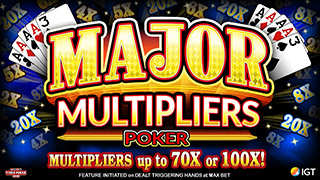Pay Table Basics
Pay Table Theory
In the beginning
In the beginning video poker was simple and only included games like single hand Draw Poker, Jacks or Better, or Bonus Poker. These game variations are not very volatile and have high hit frequency. Quads pay little and two pair return twice the wager. Given the frequency of two pairs, this allows people to play for a very long time but does not afford the excitement of any big jackpot except for the elusive and infrequent Royal Flush.
Volatility is introduced
Over time, volatility was introduced to the game by only returning even money for two pairs and using those extra 5 credits to fund other jackpots like four-of-a-kinds or even varied pay backs for different four-of-a-kinds. The next evolution was the introduction of specific combinations of four-of-a-kinds and the introduction of “kicker” cards which led to the highly popular games Double Double Bonus Poker and Triple Double Bonus Poker. The most typical modification was tightening, or loosening the Full House, Flush, Straight or some combination of each. Each of those hands happen a specific number of times, theoretically, and it is a simple way to adjust the return on a game. It is also displayed on the pay table right there in front of the players and they do notice these changes. These adjustments in either direction don’t affect the “walk-away” jackpots like quads or royals in any way but they do affect how long folks get to play for them. This is commonly referred to as “time-on-device” and is typically the key metric sought by players when seeking entertainment.
Games and pay tables can really vary
At one end of the spectrum, you have Bonus Poker and at the other a game like Triple Double Bonus Poker. Many like the high hit frequency of Deuces Wild and even more like the excitement of Double Double Bonus where aces with a 2, 3 or 4 pays half as much as a royal flush.
Players and Pay Tables
What you see is what you get
Pay tables are essentially displaying the “price” of the game being offered. Video poker is the only game that independently shows its return percentages to those who know or follow the industry. The Internet is filled with experts and would-be experts who make a living telling players about games, how to play games and which games to look for or avoid.
Strategy
Just like there are many books and tools to learn to count cards and play perfect strategy, the same is true of video poker. Also, just like blackjack, many people claim to play perfectly, but few people actually do. The nice thing about players learning which games to look for and avoid is that they feel like they are getting a good value and “shot at the house” and that is after all what the industry was founded upon.
What about the experts
Experts and the Internet can be quite influential in creating a positive or negative buzz for a casino. If you run really tight pay schedules, players will talk, and your overall play will suffer. On the other end of the spectrum, if you offer too loose games and combine that with multi-point comp specials, the word will travel at light speed and you can find yourself losing money in a hurry. Finding the balance is key.
How to Set–up Pay Tables
Dress for success
Generally, the most successful casinos set up their pay tables to return between 96% and 98%. Lower denominations should be tighter, and high limit should be looser. Each casino has its risk tolerance, but a simple set of “stair-stepping” rules to apply to pay table setup would be as follows:
| .05 and .10 .25, .50, and $1.00 $2.00+ |
94% 96% to 97% 98% to 99% |
What is stair-stepping?
“Stair-stepping” refers to tightening games offered at the lowest denomination offered and loosening them up as you increase in denomination. Theoretically, a nickel video poker player is not as valuable as a quarter or half or dollar player, so each gets a better game return based on their value as a customer.
Setting up multi-hand games
Always remember to give special consideration to your multi-hand games. Pay table returns should be set up closer to the total bet amount, not necessarily the denomination. For example, a quarter player playing single hand is a $1.25 max bet, whereas a quarter player on a 10-play game is wagering $12.50 – which is more than a $2 single-hand player. Many casinos don’t account for this properly and miss out on opportunities to attract players.
While some players will play below max bet, the vast majority will not, as they know the best odds are achieved when betting the maximum credits. Some casinos worry about jackpot exposure for dealt winners, but forget players are wagering three to ten times as many credits as a single hand game.
Click here for pay table return percentages.


